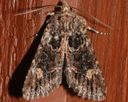Xylenina
Xylenina
Classification
- Phylum: Arthropoda
- Subphylum: Hexapoda
- Class: Insecta
- Order: Lepidoptera
- Superfamily: Noctuoidea
- Family: Noctuidae
- Subfamily: Noctuinae
- Tribe: Xylenini
- Subtribe: Xylenina
Pronunciation
How to pronounce Xylenina: //zaɪˈlɛnɪnə//
These audio files are automatically generated. While they are not always 100% accurate, they are a good starting point.
Images






Summary
The Noctuidae family, known as owlet moths, includes a vast diversity of species with significant ecological roles and impact on agriculture. With ongoing taxonomic restructuring, they remain one of the most studied families in the order Lepidoptera, reflecting their ecological and economic importance.
Physical Characteristics
Most noctuid adults have wings with various shades of browns, grays, and other colors; distinctive wing markings include claviform and reniform stigmata, with trifine hindwing venation. Larvae are commonly green or brown, some presenting bright colors; pupae range from shiny brown to dark brown, starting bright orange. Eggs are spherical and vary in color.
Identification Tips
Markings present on the wings, including the configuration of stigmata, are helpful in distinguishing species. Observation of the metathoracic structure, the nodular sclerite, and distinct wing venation can also aid in identification.
Habitat
Noctuidae species inhabit a wide variety of ecosystems; they are cosmopolitan and found globally except in the Antarctic region. Key environments include temperate and tropical regions, often associated with agricultural settings due to their larval feeding habits.
Distribution
Worldwide, except the Antarctic region; various species are found at elevations up to 4,000 m. Notably diverse in North America, Europe, and parts of Asia and Africa.
Diet
Most caterpillars (larvae) are herbivorous, feeding on various plants, including some that are toxic. Adult moths visit flowers for nectar, and some species engage in predation on other insect larvae during the caterpillar stage.
Life Cycle
Typically, Noctuidae are multivoltine, reproducing from spring to fall in temperate regions. Species may exhibit one or multiple broods per year, depending on environmental conditions.
Reproduction
Reproductive season spans spring to fall, with some species being multivoltine. The use of pheromones for mating attraction is common among many species.
Predators
Predators include birds, bats, and other insectivorous animals. Some caterpillars exhibit defensive mechanisms to deter predation, including mimicry and chemical defenses.
Ecosystem Role
Moths in this family play an important role in pollination and serve as both herbivores and prey within various ecosystems. Their larvae are significant herbivores in many agricultural settings.
Economic Impact
Many noctuid larvae are agricultural pests, such as cutworms and armyworms, causing significant crop damage and economic loss. For example, Helicoverpa armigera leads to over $2 billion in losses annually.
Collecting Methods
- Light trapping
- Net collecting at flowers
- Hand collecting from host plants
Preservation Methods
- Specimen drying
- Pinning
- Alcohol preservation
Evolution
Ongoing molecular studies and classifications continue to shape the understanding of Noctuidae relationships, indicating it is a monophyletic group largely defined by specific venational characteristics.
Similar Taxa
- Erebidae
- Notodontidae
- Lymantriidae
Misconceptions
Common misconceptions include the assumption that all 'cutworms' refer to the larvae of Noctuidae, while other insect families also have similar-feeding larvae.
Tags
- Lepidoptera
- Noctuidae
- owlet moths
- agricultural pests
- ecological role